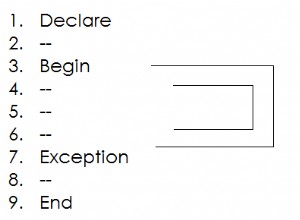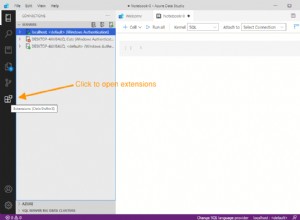La causa tipica di un'App, che utilizza SQLite e che copia un database preesistente improvvisamente non funzionante per API 28 è quella di aggirare il problema del database cartella non esistente (la copia fallirebbe se la directory non esistesse) è creare un database vuoto e quindi sovrascrivere il database.
Tuttavia, come per impostazione predefinita, dall'API 28, l'SDK utilizza WAL (Write-ahead logging) e che la creazione del database vuoto da sovrascrivere comporta la creazione dei file -shm e -wal. È l'esistenza di questi file che fa sì che il database sia vuoto dopo la copia.
- Credo che ciò sia dovuto al fatto che una volta aperto il database copiato, viene rilevata una discrepanza e i metodi dell'SDK creano un database utilizzabile vuoto (questa è una congettura e non è stato effettivamente dimostrato che lo sia).
Risoluzione rapida
La soluzione rapida, ma non consigliata, consiste nell'overridere onConfigure metodo nella classe che sottoclassi SQLiteOpenHelper per utilizzare il disableWriteAheadLogging metodo in modo che il database venga aperto in modalità journal.
- il codice completo di seguito (2a parte di codice) include questo, ma la riga è stata commentata.
Correzione consigliata
Il metodo consigliato, per trarre vantaggio dai vantaggi di WAL, è verificare l'esistenza della directory del database e creare la directory se non esiste piuttosto che creare un database da sovrascrivere (e quindi il - shm e -wal non esistono quando il database viene copiato )
Quello che segue è un metodo di esempio in cui la directory viene controllata/creata durante il controllo per vedere se il database esiste (ovviamente questo dovrebbe essere adattato di conseguenza ) :-
private boolean checkDataBase() {
/**
* Does not open the database instead checks to see if the file exists
* also creates the databases directory if it does not exists
* (the real reason why the database is opened, which appears to result in issues)
*/
File db = new File(myContext.getDatabasePath(DB_NAME).getPath()); //Get the file name of the database
if (db.exists()) return true; // If it exists then return doing nothing
// Get the parent (directory in which the database file would be)
File dbdir = db.getParentFile();
// If the directory does not exits then make the directory (and higher level directories)
if (!dbdir.exists()) {
db.getParentFile().mkdirs();
dbdir.mkdirs();
}
return false;
}
- Nota che questo si basa sul fatto che la variabile DB_NAME sia il nome del database (nome del file del database) e che la posizione finale del database è la posizione standard (data/data/the_package/databases/).
Quanto sopra è stato estratto dalla seguente sottoclasse di SQLiteOpenHelper :-
public class DBHelper extends SQLiteOpenHelper {
private static String DB_NAME = "db";
private SQLiteDatabase myDataBase;
private final Context myContext;
private int bytes_copied = 0;
private static int buffer_size = 1024;
private int blocks_copied = 0;
public DBHelper(Context context) {
super(context, DB_NAME, null, 1);
this.myContext = context;
// Check for and create (copy DB from assets) when constructing the DBHelper
if (!checkDataBase()) {
bytes_copied = 0;
blocks_copied = 0;
createDataBase();
}
}
/**
* Creates an empty database on the system and rewrites it with your own database.
* */
public void createDataBase() {
boolean dbExist = checkDataBase(); // Double check
if(dbExist){
//do nothing - database already exists
} else {
//By calling this method an empty database will be created into the default system path
//of your application so we are gonna be able to overwrite that database with our database.
//this.getReadableDatabase();
//<<<<<<<<<< Dimsiss the above comment
//By calling this method an empty database IS NOT created nor are the related -shm and -wal files
//The method that creates the database is flawed and was only used to resolve the issue
//of the copy failing in the absence of the databases directory.
//The dbExist method, now utilised, checks for and creates the database directory, so there
//is then no need to create the database just to create the databases library. As a result
//the -shm and -wal files will not exist and thus result in the error associated with
//Android 9+ failing with due to tables not existining after an apparently successful
//copy.
try {
copyDataBase();
} catch (IOException e) {
File db = new File(myContext.getDatabasePath(DB_NAME).getPath());
if (db.exists()) {
db.delete();
}
e.printStackTrace();
throw new RuntimeException("Error copying database (see stack-trace above)");
}
}
}
/**
* Check if the database already exist to avoid re-copying the file each time you open the application.
* @return true if it exists, false if it doesn't
*/
private boolean checkDataBase() {
/**
* Does not open the database instead checks to see if the file exists
* also creates the databases directory if it does not exists
* (the real reason why the database is opened, which appears to result in issues)
*/
File db = new File(myContext.getDatabasePath(DB_NAME).getPath()); //Get the file name of the database
Log.d("DBPATH","DB Path is " + db.getPath()); //TODO remove for Live App
if (db.exists()) return true; // If it exists then return doing nothing
// Get the parent (directory in which the database file would be)
File dbdir = db.getParentFile();
// If the directory does not exits then make the directory (and higher level directories)
if (!dbdir.exists()) {
db.getParentFile().mkdirs();
dbdir.mkdirs();
}
return false;
}
/**
* Copies your database from your local assets-folder to the just created empty database in the
* system folder, from where it can be accessed and handled.
* This is done by transfering bytestream.
* */
private void copyDataBase() throws IOException {
final String TAG = "COPYDATABASE";
//Open your local db as the input stream
Log.d(TAG,"Initiated Copy of the database file " + DB_NAME + " from the assets folder."); //TODO remove for Live App
InputStream myInput = myContext.getAssets().open(DB_NAME); // Open the Asset file
String dbpath = myContext.getDatabasePath(DB_NAME).getPath();
Log.d(TAG,"Asset file " + DB_NAME + " found so attmepting to copy to " + dbpath); //TODO remove for Live App
// Path to the just created empty db
//String outFileName = DB_PATH + DB_NAME;
//Open the empty db as the output stream
File outfile = new File(myContext.getDatabasePath(DB_NAME).toString());
Log.d("DBPATH","path is " + outfile.getPath()); //TODO remove for Live App
//outfile.setWritable(true); // NOT NEEDED as permission already applies
//OutputStream myoutputx2 = new FileOutputStream(outfile);
/* Note done in checkDatabase method
if (!outfile.getParentFile().exists()) {
outfile.getParentFile().mkdirs();
}
*/
OutputStream myOutput = new FileOutputStream(outfile);
//transfer bytes from the inputfile to the outputfile
byte[] buffer = new byte[buffer_size];
int length;
while ((length = myInput.read(buffer))>0) {
blocks_copied++;
Log.d(TAG,"Ateempting copy of block " + String.valueOf(blocks_copied) + " which has " + String.valueOf(length) + " bytes."); //TODO remove for Live App
myOutput.write(buffer, 0, length);
bytes_copied += length;
}
Log.d(TAG,
"Finished copying Database " + DB_NAME +
" from the assets folder, to " + dbpath +
String.valueOf(bytes_copied) + "were copied, in " +
String.valueOf(blocks_copied) + " blocks of size " +
String.valueOf(buffer_size) + "."
); //TODO remove for Live App
//Close the streams
myOutput.flush();
myOutput.close();
myInput.close();
Log.d(TAG,"All Streams have been flushed and closed."); //TODO remove for Live App
}
@Override
public synchronized void close() {
if(myDataBase != null)
myDataBase.close();
super.close();
}
@Override
public void onCreate(SQLiteDatabase db) {
}
@Override
public void onUpgrade(SQLiteDatabase db, int oldVersion, int newVersion) {
}
@Override
public void onConfigure(SQLiteDatabase db) {
super.onConfigure(db);
Log.d("DBCONFIGURE","Database has been configured "); //TODO remove for Live App
//db.disableWriteAheadLogging(); //<<<<<<<<<< un-comment to force journal mode
}
@Override
public void onOpen(SQLiteDatabase db) {
super.onOpen(db);
Log.d("DBOPENED","Database has been opened."); //TODO remove for live App
}
}
- Nota che il codice sopra è/era destinato allo sviluppo/sperimentazione e quindi include codice che potrebbe essere rimosso.




